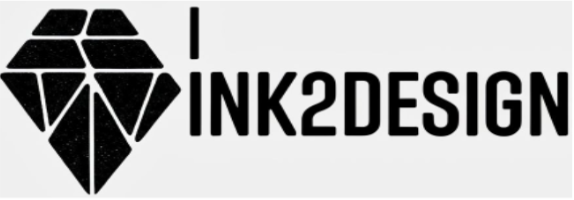T-shirt Design
T-Shirt Printing Methods: Which One is Right for You?
At Ink2Design, we use various printing techniques to ensure the best quality and durability for our custom T-shirts. Choosing the right printing method depends on factors like the type of fabric, design complexity, order quantity, and budget. In this blog, we’ll break down the most popular T-shirt printing methods: Direct to Garment (DTG), Direct to Film (DTF), Silkscreen, Heat Press, and Heat Press Vinyl/PU.
1. Direct to Garment (DTG) Printing
Process:
DTG uses a specialized inkjet printer to print designs directly onto the fabric. The ink absorbs into the fibers, creating a smooth and high-quality finish.
Best For:
-
100% cotton T-shirts and other soft fabrics
-
Complex, full-color designs with gradients and shading
Number of Colors:
-
Unlimited (ideal for photorealistic prints)
Minimum Order Quantity:
-
No minimum (great for one-off designs and small orders)
Advantages:
✔ High detail and vibrant colors
✔ Soft feel with no noticeable texture
✔ Ideal for small orders and custom prints
Disadvantages:
✖ Works best on cotton fabrics (not ideal for polyester)
✖ Slower production time compared to screen printing
✖ Less durable than screen printing on dark fabrics
2. Direct to Film (DTF) Printing
Process:
DTF involves printing a design onto a special film, applying adhesive powder, and then heat-pressing it onto the garment. The ink bonds with the fabric, creating a durable print.
Best For:
-
Cotton, polyester, blends, and even dark fabrics
-
Small batch printing and detailed designs
Number of Colors:
-
Unlimited (full-color and photorealistic prints)
Minimum Order Quantity:
-
No minimum (ideal for custom, one-off designs)
Advantages:
✔ Works on almost any fabric
✔ Vibrant colors with good durability
✔ No pre-treatment needed like DTG
Disadvantages:
✖ Slightly thicker feel on fabric compared to DTG
✖ Less breathable than DTG prints
✖ Can crack over time with frequent washing
3. Silkscreen Printing (Screen Printing)
Process:
A stencil (screen) is created for each color in the design. Ink is pushed through the screen onto the fabric, layer by layer.
Best For:
-
Cotton and polyester garments
-
Bulk orders with simple designs (logos, text, basic graphics)
Number of Colors:
-
Limited to around 6-8 colors (each color requires a separate screen)
Minimum Order Quantity:
-
25+ pieces (cost-effective for large orders)
Advantages:
✔ Highly durable and long-lasting prints
✔ Cost-effective for bulk orders
✔ Vibrant and thick ink coverage
Disadvantages:
✖ Expensive for small orders (each color needs a separate screen)
✖ Not suitable for designs with gradients or unlimited colors
✖ Longer setup time
4. Heat Press Printing
Process:
A design is printed onto transfer paper and then heat-pressed onto the fabric. The heat activates the ink or adhesive, permanently bonding the design to the T-shirt.
Best For:
-
Polyester and cotton fabrics
-
Full-color designs with gradients
Number of Colors:
-
Unlimited (depends on the transfer type used)
Minimum Order Quantity:
-
No minimum (great for small custom orders)
Advantages:
✔ Can print complex, detailed designs
✔ Great for short runs and one-off prints
✔ Works well on various fabrics
Disadvantages:
✖ Print can feel thicker compared to DTG or silkscreen
✖ Less durable over time (may fade or crack after many washes)
✖ Slower production process for large orders
5. Heat Press Vinyl / PU (Polyurethane) Printing
Process:
Vinyl or PU material is cut into shapes or letters, then heat-pressed onto the fabric. Often used for bold, single-color designs.
Best For:
-
Cotton, polyester, and performance fabrics
-
Names, numbers, and simple graphics (e.g., sports jerseys, slogans)
Number of Colors:
-
Limited (each vinyl layer is a separate color)
Minimum Order Quantity:
-
No minimum (ideal for custom name/number printing)
Advantages:
✔ Extremely durable, doesn’t fade or crack easily
✔ Great for one-off or small batch orders
✔ Vibrant colors with a smooth, professional look
Disadvantages:
✖ Limited to simple, solid-colored designs
✖ Can feel thicker compared to DTG or screen printing
✖ Not ideal for large, complex graphics
Which Printing Method Should You Choose?
| Printing Method | Best For | No. of Colors | Min. Order | Durability | Best Fabric Type |
|---|---|---|---|---|---|
| DTG | Complex, full-color designs | Unlimited | No minimum | Moderate | Cotton |
| DTF | Detailed prints on any fabric | Unlimited | No minimum | High | Cotton, polyester, blends |
| Silkscreen | Bulk orders with simple designs | 6-8 max | 25+ pieces | Very High | Cotton, polyester |
| Heat Press | Full-color, one-off prints | Unlimited | No minimum | Moderate | Cotton, polyester |
| Heat Press Vinyl | Names, logos, and simple graphics | 1-3 colors | No minimum | High | Cotton, polyester |
Final Thoughts
Choosing the right printing method depends on your needs. If you want high-detail, full-color prints, DTG or DTF is the best option. If you need bulk orders with durability, go for silkscreen. For custom name prints or sports jerseys, heat press vinyl is the way to go.
At Ink2Design, we offer all these printing methods to ensure you get the best quality for your T-shirts. If you’re unsure which method suits your design, contact us, and we’ll be happy to help!

